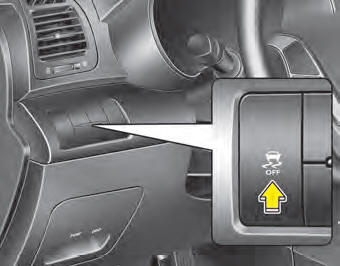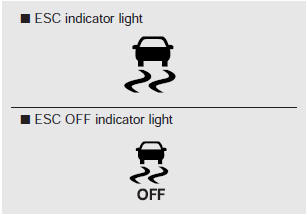 Kia Sorento: Electronic stability control (ESC)
Kia Sorento: Electronic stability control (ESC)

The Electronic Stability control (ESC) system is designed to stabilize the vehicle during cornering maneuvers. ESC checks where you are steering and where the vehicle is actually going. ESC applies the brakes on individual wheels and intervenes with the engine management system to stabilize the vehicle.
WARNING
Never drive too fast according to the road conditions or too quickly when cornering. Electronic stability control (ESC) will not prevent accidents. Excessive speed in turns, abrupt maneuvers and hydroplaning on wet surfaces can still result in serious accidents. Only a safe and attentive driver can prevent accidents by avoiding maneuvers that cause the vehicle to lose traction. Even with ESC installed, always follow all the normal precautions for driving - including driving at safe speeds for the conditions.
The Electronic Stability Control (ESC) system is an electronic system designed to help the driver maintain vehicle control under adverse conditions. It is not a substitute for safe driving practices. Factors including speed, road conditions and driver steering input can all affect whether ESC will be effective in preventing a loss of control. It is still your responsibility to drive and corner at reasonable speeds and to leave a sufficient margin of safety.
When you apply your brakes under conditions which may lock the wheels, you may hear a ŌĆ£tik-tikŌĆÖŌĆÖ sound from the brakes, or feel a corresponding sensation in the brake pedal. This is normal and it means your ESC is active.
✽ NOTICE
A click sound may be heard in the engine compartment when the vehicle begins to move after the engine is started. These conditions are normal and indicate that the Electronic Stability Control System is functioning properly.
ESC operation
ESC ON condition

- When the ignition is turned ON, ESC and ESC OFF indicator lights illuminate for approximately 3 seconds, then ESC is turned on.
- Press the ESC OFF button for at least half a second after turning the ignition ON to turn ESC off. (ESC OFF indicator will illuminate). To turn the ESC on, press the ESC OFF button (ESC OFF indicator light will go off).
- When starting the engine, you may hear a slight ticking sound. This is the ESC performing an automatic system self-check and does not indicate a problem.
When operating

When the ESC is in operation, the ESC indicator light blinks.
- When the Electronic Stability Control is operating properly, you can feel a slight pulsation in the vehicle. This is only the effect of brake control and indicates nothing unusual.
- When moving out of the mud or driving on a slippery road, pressing the accelerator pedal may not cause the engine rpm (revolutions per minute) to increase.
ESC operation off
ESC OFF state

This car has 2 kinds of ESC off states.
If the engine stops when ESC is off, ESC remains off. Upon restarting the engine, the ESC will automatically turn on again.
ESC off state 1
To cancel ESC operation, press the ESC OFF button (ESC OFF
 ) shortly (ESC OFF indicator
) shortly (ESC OFF indicator
light (ESC OFF 
) illuminates). At this state, the engine control function does not operate.
It means the traction control function does not operate. Brake control function
only operates.
ESC off state 2
To cancel ESC operation, press the ESC OFF button (ESC OFF
 ) for more
) for more
than 3 seconds. ESC OFF indicator light (ESC OFF
 ) illuminates
) illuminates
and ESC OFF warning chime will sound. At this state, the engine control function
and brake control function do not operate. It means the car stability control function
does not operate any more.
Indicator light

When ignition switch is turned to ON, the indicator light illuminates, then goes off if the ESC system is operating normally.
The ESC indicator light blinks whenever ESC is operating or illuminates when ESC fails to operate.
The ESC OFF indicator light comes on when the ESC is turned off with the button.
CAUTION
Driving with varying tire or wheel sizes may cause the ESC system to malfunction. When replacing tires, make sure they are the same size as your original tires.
WARNING
The Electronic Stability Control system is only a driving aid; use precautions for safe driving by slowing down on curved, snowy, or icy roads. Drive slowly and donŌĆÖt attempt to accelerate whenever the ESC indicator light is blinking, or when the road surface is slippery.
ESC OFF usage
When driving
- ESC should be turned on for daily driving whenever possible.
- To turn ESC off while driving, press the ESC OFF button while driving on a flat road surface.
WARNING
Never press the ESC OFF button while ESC is operating (ESC indicator light blinks). If ESC is turned off while ESC is operating, the vehicle may slip out of control.
✽ NOTICE
- When operating the vehicle on a dynamometer, ensure that the ESC is turned off (ESC OFF light illuminated). If the ESC is left on, it may prevent the vehicle speed from increasing, and result in false diagnosis.
- Turning the ESC off does not affect ABS or brake system operation.
Vehicle stability management (VSM)
This system provides further enhancements to vehicle stability and steering responses when a vehicle is driving on a slippery road or a vehicle detects changes in coefficient of friction between right wheels and left wheels when braking.
VSM operation
When the VSM is in operation, ESC indicator light (
 ) blinks.
) blinks.
When the vehicle stability management is operating properly, you can feel a slight pulsation in the vehicle and/or abnormal steering responses (EPS). This is only the effect of brake and EPS control and indicates nothing unusual.
The VSM does not operate when:
- Driving on bank road such as gradient or incline
- Driving in reverse
- ESC OFF indicator light (
 )
)
remains on the instrument cluster - EPS indicator light remains on the instrument cluster
VSM operation off
If you press the ESC OFF button to turn off the ESC, the VSM will also cancel
and the ESC OFF indicator light (  )
)
illuminates.
To turn on the VSM, press the button again. The ESC OFF indicator light goes out.
Malfunction indicator
The VSM can be deactivated even if you donŌĆÖt cancel the VSM operation by pressing
the ESC OFF button. It indicates that a malfunction has been detected somewhere
in the Electric Power Steering system or VSM system. If the ESC indicator light
( ) or EPS warning light remains on,
) or EPS warning light remains on,
take your vehicle to an authorized Kia dealer and have the system checked.
✽ NOTICE
- The VSM is designed to function above approximately 9 mph (15 km/h) on curves.
- The VSM is designed to function above approximately 18 mph (30 km/h) when a vehicle is braking on a split-mu road. The split-mu road is made of surfaces which have different friction forces.
WARNING
- The Vehicle Stability Management system is not a substitute for safe driving practices but a supplementary function only. It is the responsibility of the driver to always check the speed and the distance to the vehicle ahead. Always hold the steering wheel firmly while driving.
- Your vehicle is designed to activate according to the driverŌĆÖs intention, even with installed VSM. Always follow all the normal precautions for driving at safe speeds for the conditions ŌĆō including driving in clement weather and on a slippery road.
- Driving with varying tire or wheel sizes may cause the VSM system to malfunction. When replacing tires, make sure they are the same size as your original tires.
 Anti-lock brake system (ABS)
Anti-lock brake system (ABS)
WARNING
ABS (or ESC) will not prevent accidents due to improper or dangerous driving
maneuvers. Even though vehicle control is improved during emergency braking, always
maintain a safe distance bet ...
 Hill-start assist control (HAC)
Hill-start assist control (HAC)
A vehicle has the tendency to roll back on a steep hill when it starts to go
after stopping. The Hill-start Assist Control (HAC) prevents the vehicle from rolling
back by applying the brakes automat ...
See also:
Air Ventilation Seat Control Unit Removal
1.
Disconnect the negative (-) battery terminal.
2.
Remove the air ventilation seat control unit (A) after loosening
screws.
...
Using the USB device
To use an external USB device, make sure the device is not connected when
starting up the vehicle. Connect the device after starting up.
If you start the engine when the USB device is connected ...
Cruise Control Switch Removal
1.
Disconnect the battery (-) terminal.
2.
Remove the air-bag module from the steering wheel. ( Refer to
RT group)
3.
...
